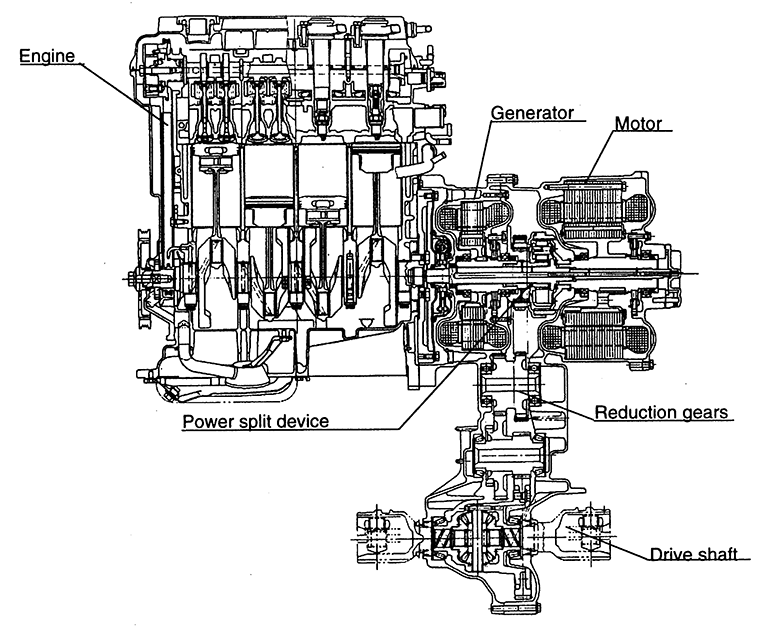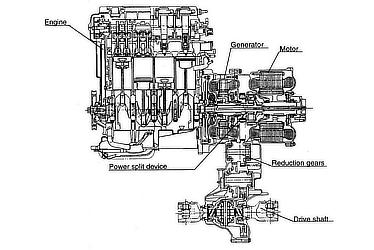Mar. 25, 1997
Toyota Introduces New Passenger Vehicle Hybrid System
Vehicle Using the Hybrid System to be Marketed in 1997
Tokyo―TOYOTA MOTOR CORPORATION (TMC) announced today that, as part of its Toyota Eco-Project, it has developed a highly advanced hybrid system for powering mass-produced passenger cars. The Toyota Hybrid System uses a gasoline engine, electric motor, and electric generator to achieve nearly twice the fuel efficiency of conventional gasoline engine cars and significantly reduce exhaust emissions. Toyota plans to market a passenger vehicle using this system within the year.
The system builds on earlier successes by Toyota to develop environment-friendly, low fuel consumption engines such as the lean-burn engine in 1984, and the Toyota D-4 direct injection gasoline engine in 1996.
The Toyota Hybrid System incorporates the technologies of clean, high-efficiency gasoline engines, electric vehicle power systems based on nickel-metal hydride batteries, advanced automatic transmissions, and precision power control. The combination of these technologies into a single power train unit provides clean emissions and outstanding fuel consumption (about 28 km/L in 10.15 mode; Toyota test figure).
The Toyota Hybrid System has two motive power sources which engage depending on driving conditions. An improved efficiency gasoline engine provides the main power to drive the wheels, as in conventional automobiles. Drive power can also be supplied by an electric motor, which derives its electricity from the nickel-metal hydride battery and an electric generator. Fuel efficiency is further boosted by other measures, such as automatically cutting the engine when the vehicle is at a stop and regenerating the energy accumulated during deceleration.
Compared with conventional vehicles with a 1.5-liter engine running in 10.15 mode, the amount of CO2 emissions are reduced by half (based on in-house test results). Moreover, with the use of VVT-i*1 and the electric motor to reduce engine load during acceleration, HC, CO, and NOx emissions are cut to about 1/10th of previous levels (Toyota test figures) .
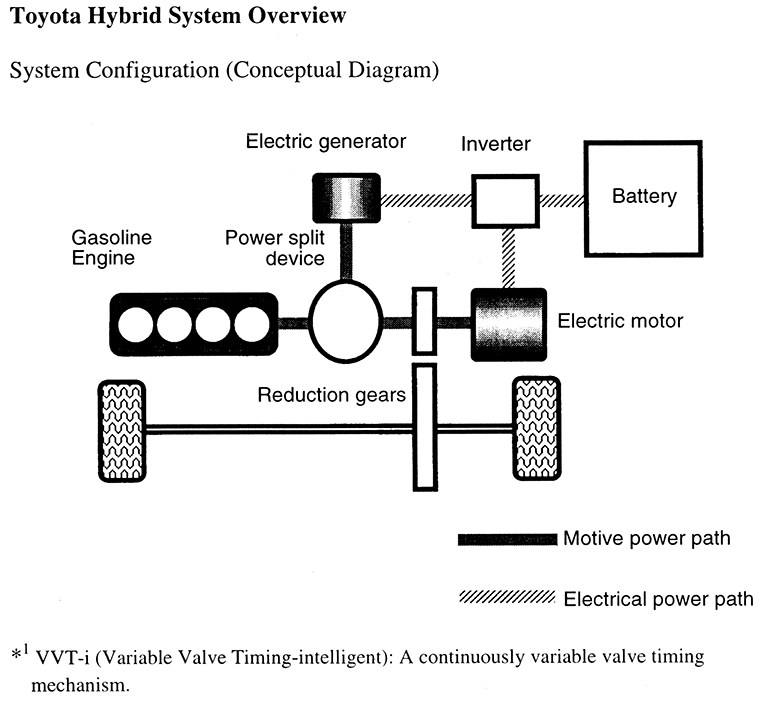
- Division of Gasoline Engine Power Enables Highly Efficient Operation
The power split device in the hybrid transmission allocates power from the gasoline engine either directly to the vehicle's wheels or to the electric generator. At the same time, the gasoline engine is automatically controlled to keep its rate of revolution (indicated by rpm) in the most efficient range. The power to drive the vehicle is appropriated from the gasoline engine or from the electric motor in response to driving conditions.
- Hybrid transmission
The transmission consists of the power split device, the electric generator, and the electric motor. The power split device utilizes a planetary gear to constantly reallocate the power supplied from the gasoline engine. One of the output shafts of the power split device is linked to the electric motor and wheels, while the other connects to the electric generator.
The entire transmission system functions as an electronically controlled continuously variable transmission by fluidly adjusting the rates of revolution of the gasoline engine, electric generator, and electric motor to accommodate for acceleration and deceleration.
- Highly efficient operation control
As part of the transmission's control system, the gasoline engine is regulated to keep it operating within the high torque zone, which is the most fuel efficient (ratio of power to fuel consumption). Its rate of revolution is automatically controlled to keep it within a set range, so that the high torque zone can be used as much as driving conditions allow.
The distribution of the gasoline engine's power is determined by factors such as the amount of pressure on the accelerator, vehicle speed, and battery charge, The portion that is used to turn the wheels is balanced with that which is used to generate electrical power. Electrical power created by the generator may then be utilized to operate the electric motor, which, together with the power derived directly from the gasoline engine, helps drive the vehicle.
- High Efficiency Engine
The gasoline engine is the hybrid system's main power source. It is a high expansion ratio gasoline engine using the highly heat-efficient Atkinson Cycle*2. Its efficiency is further improved by the use of VVT-i and by reducing friction loss between its components.
- High Expansion Ratio Cycle
The high expansion ratio heat cycle increases the expansion ratio by reducing the volume of the combustion chambers and allows combustion energy to be used more effectively. Engine knock is also avoided by delaying the timing intake valve closure, since this reduces compression pressure. Moreover, pumping loss is reduced because of decreased intake resistance during times of partial load.
- Reduction of friction loss
The low-revolution, highly fuel-efficient 1.5-liter engine has a top revolution rate of only 4,000 rpm, thus requiring a lower degree of parts strength than high revving engines. Moving parts are lighter, the crankshaft has a smaller diameter, piston rings have lower tension, and the valve spring load is less, resulting in a large reduction of friction loss.
- Large Reduction of Energy Loss; Energy Regeneration
The Toyota Hybrid System's unprecedented high efficiency is partly the result of measures to reduce and recover energy that is normally lost in vehicles with conventional engines.
- *2Atkinson Cycle
- A heat cycle proposed by British engineer James Atkinson, the improved version of which is called the Miller Cycle. The Atkinson Cycle is very heat efficient compared to conventional engines, but is rarely applied because it does not produce enough power unless used with a supercharger.
- Engine stop
When the vehicle stops or decelerates at low speed, the gasoline engine automatically stops operating to reduce energy waste. When the vehicle accelerates from rest, initial power is provided by the electric motor, and the engine begins operating only later. Also, at extremely low speeds or when the gasoline engine is operating in the low efficiency zone (low rpm), the fuel is cut off and the vehicle is driven by the electric motor alone.
- Regeneration of energy during deceleration
During engine braking or braking using the foot brake, the electric motor operates as a generator, converting the vehicle's kinetic energy into electrical energy, which is used to charge the battery.
The system is particularly effective in recovering energy during city driving, where driving patterns with repeated acceleration and deceleration are common.
To maintain constant charge, the nickel-metal hydride battery receives charging energy from the electric motor and the engine-powered electric generator via a sophisticated charging control system. The battery does not require external charging.
- System Operation Conditions
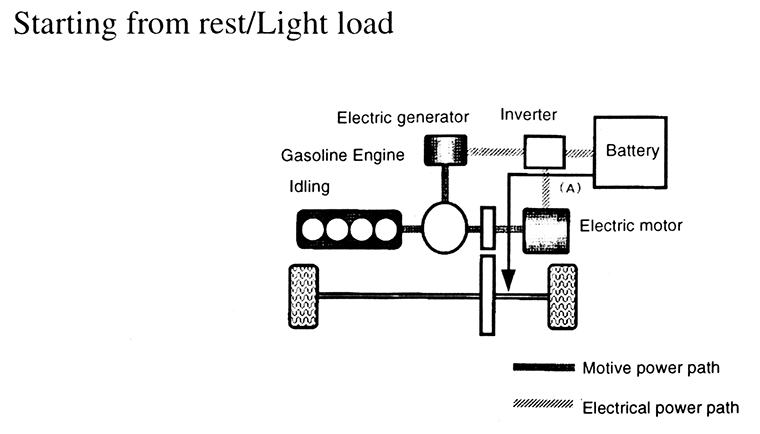
If the engine is in the low efficiency zone―vehicle is starting from rest, moving at very low speed, or descending a slight gradient―the fuel supply is cut or the engine is stopped and the electric motor drives the vehicle (A).
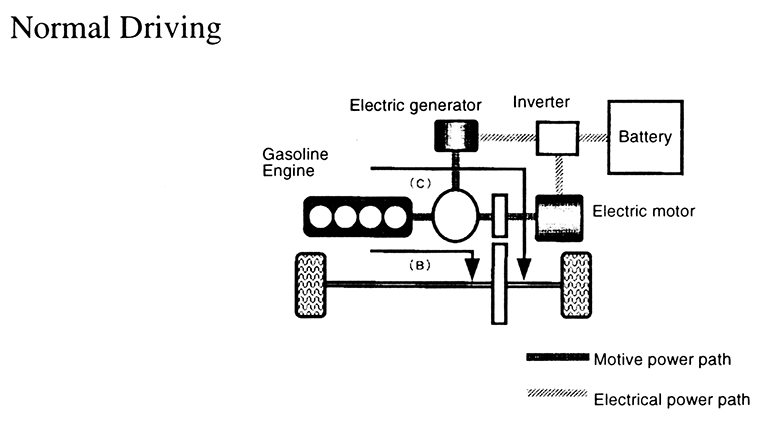
Engine power is divided in two directions by the power split device, one route directly powering the wheels (B) and the other operating the electric generator. Electricity from the generator runs the electric motor to assist with powering the wheels (C). The system controls the ratio of these paths to enable maximum efficiency.
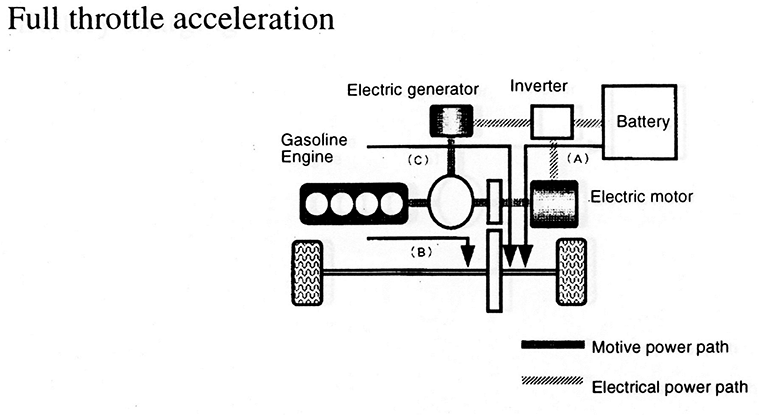
During full throttle acceleration, power is also supplied from the battery to augment the drive power (A).
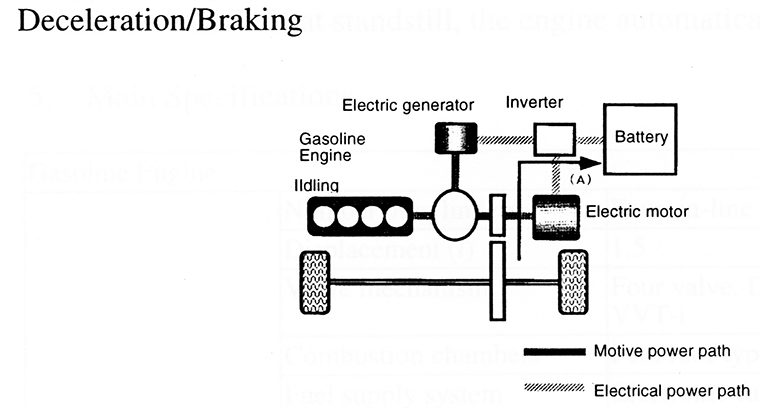
During deceleration and braking, kinetic energy from the wheels passes through the electric motor, which functions as a generator (A). Recovered energy is stored in the battery.

The battery is regulated to maintain a constant charge. When the charge is low, the electric generator routes power to charge the battery (D).
When the vehicle is at standstill, the engine automatically stops.
- Main Specifications
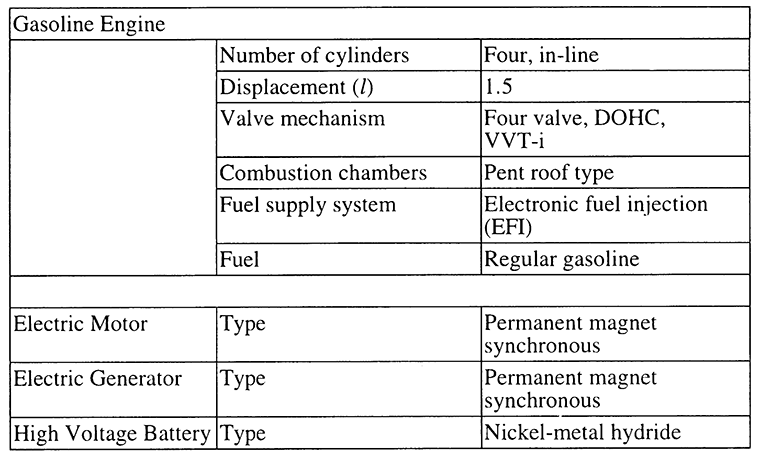
- Cross Section of Engine and Drive Units
